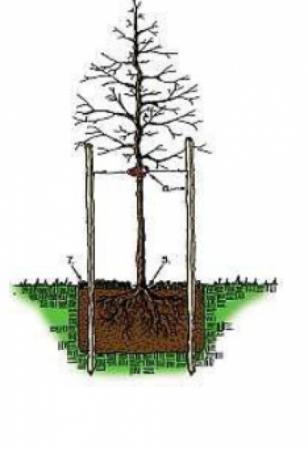Tree Planting Diagram
- Planting hole should be about twice the diameter of the container, root ball or root spread so that the roots can grow easily in the 'loosened' soil.
- Prune off dead, diseased, broken or twisted roots on bare root plants.
- Usually, soil dug from the planting hole is satisfactory for back filling. In sandy soil, amending with 1/2 peat moss or well rotted manure to 3/4 topsoil may be beneficial. Break up large clumps and discard any debris or stones.
- Remove burlap from 1/3 of root ball on balled and burlap trees after tree is placed in planting hole. Remove any containers before planting. Remove all twine or rope from around the trunk.
- The original ground level in the nursery (the soil line on bare root trees or the top of the root ball) should be 1-2" above the finished ground level where planted.
- Water down planting soil several times while back filling roots to eliminate air pockets.
- Mulch at least a 30" diameter area around the tree trunk with wood chips, bark, coarse gravel or small rock.
- Staking the tree may be necessary on taller, whippy trees. Use wooden 2x2's or steel pipe. Run wire through rubber hose to protect tree trunk.
- Trim off all dead or broken branches after planting. Trim side branches back approximately 1/3 of the length to a bud or twig junction. Do not remove central leader.
- Water thoroughly after planting. Water thoroughly once every 7-10 days for at least two growing seasons (a thorough water should wet the soil to a depth of at least 24"). More frequent watering may keep the soil too wet and rot the roots on newly planted trees. Automatic lawn sprinklers that run every 3-4 days can drown your tree if the soil remains wet constantly. In this case, plant the tree a little higher and slope the soil away from the tree trunk so that water will run off away from the tree.

